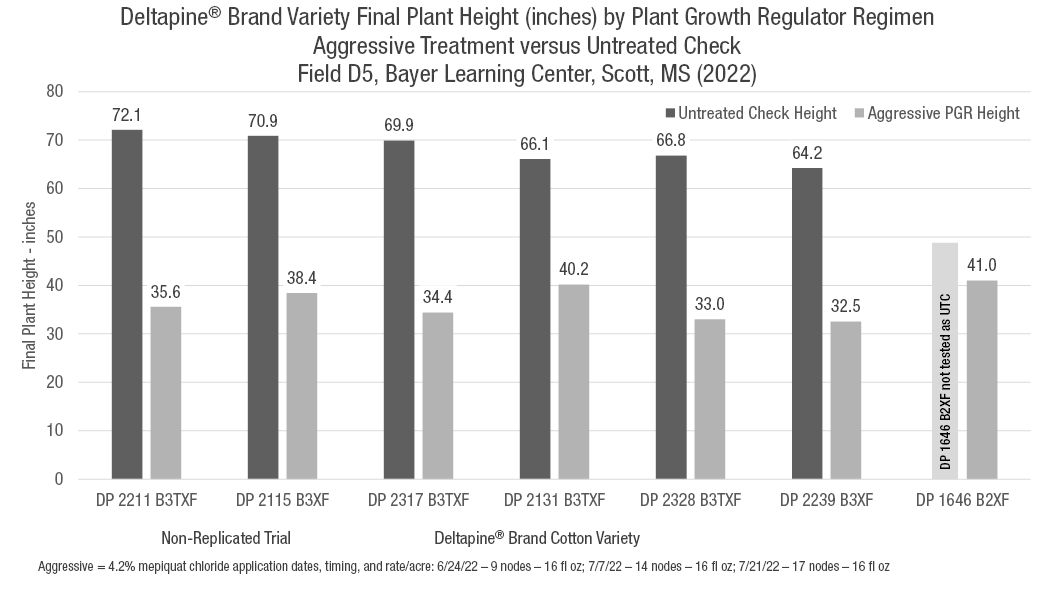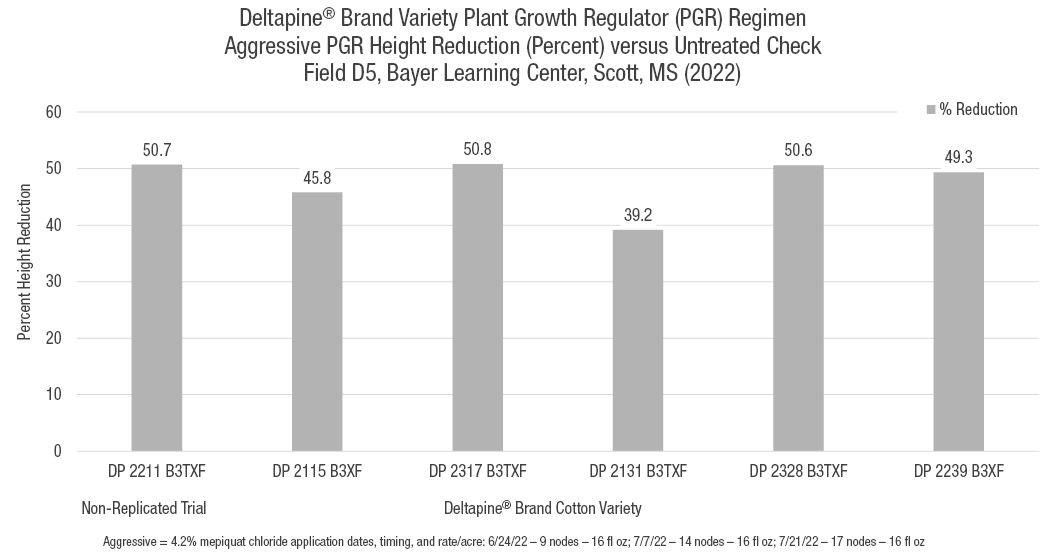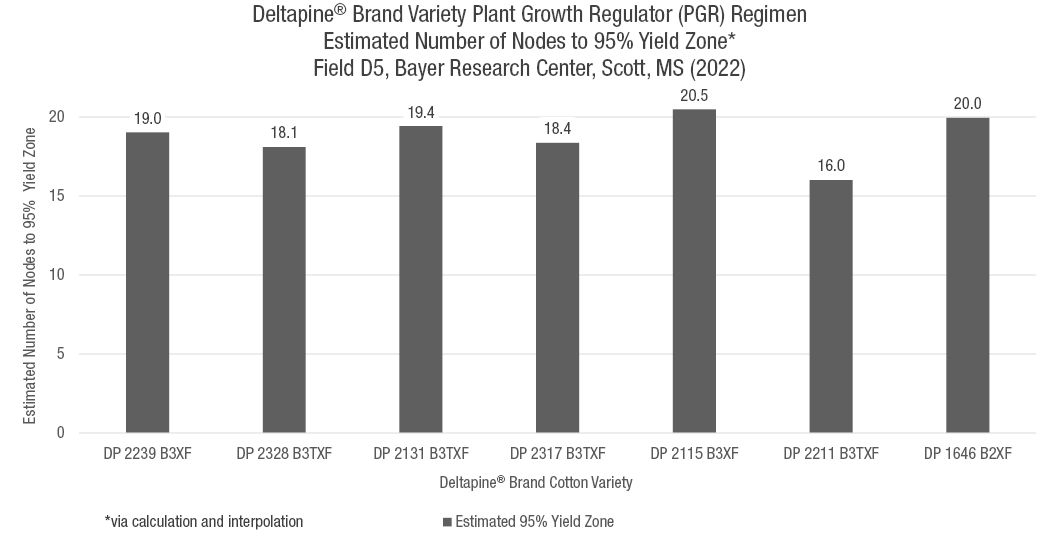Response of Deltapine® Brand Bollgard® 3 ThryvOn™ Cotton with XtendFlex® Technology Varieties to Plant Growth Regulator (PGR) Regimens (2022)
March 21, 2023
TRIAL OBJECTIVE
- The objective of this study at the Bayer Learning Center at Scott, Mississippi was to evaluate the response of Deltapine® brand Bollgard® 3 ThryvOn™ cotton with XtendFlex® Technology to plant growth regulator (PGR) regimens.
- Cotton PGR response is an important management characteristic to consider when selecting a cotton variety to plant and it is particularly important when considering recently introduced technologies such as ThryvOn™ Technology.
- Proper PGR management helps optimize Deltapine® brand cotton variety return on investment.
RESEARCH SITE DETAILS

- All weed, insect, and agronomic inputs were per local recommendations except PGR applications.
- 110 lb/acre of nitrogen (N) was applied as 28-0-0-4 (N-P-K-S) before layby.
- PGR Regimens:
- Untreated Check (UTC) – no PGR applied.
- Aggressive Regimen – PGR applications that are the most biologically and legally aggressive which usually begin at 8 to 9 nodes and at relatively high rates.
- Application dates, timing, and rates for 4.2% mepiquat chloride:
- 6/24/2022 - 9 nodes - 16 fl oz/acre.
- 7/7/2022 - 14 nodes - 16 fl oz/acre.
- 7/21/2022 - 17 nodes - 16 fl oz/acre.
- Application dates, timing, and rates for 4.2% mepiquat chloride:
- Trial Information:
- Plots were planted as a single replicate (1.0 acre/plot) and machine harvested.
- Aggressively managed plots were sampled for lint turnout and fiber quality; yield estimates for all treatments were based on these parameters.
- Four row feet per experimental unit was positionally mapped using the Boll-O-Meter.
- Cotton varieties that did not have ThryvOn™ Technology were treated for thrips (Thysanoptera: Thripidae), Lygus or tarnished plant bug (Lygus lineolaris), and bollworm (Helicoverpa armigera) based on insect thresholds and fruiting profile.
- Table 1 includes the cotton varieties planted in this trial.
Table 1. Deltapine® brand cotton varieties planted.

UNDERSTANDING THE RESULTS
- The 2022 growing season for cotton was very harsh early in the season followed by good growing conditions. The characteristics of the season included:
- On time planting.
- A wet early season leading to a below average early fruit set in all tested varieties.
- After the early rains ended, cotton crops at the Learning Center began to fruit normally and ultimately had very good yield potential.
- Data from this trial showed similar results to another 2022 PGR trial at the Scott Learning Center; however, each case is specific and interesting characteristics of some products were identified.
- Insecticide applications for thrips, Lygus, and bollworm:
- One application for thrips.
- Three applications for Lygus.
- No applications needed for bollworm.
- Plant Heights - Across all the products tested, the aggressively treated plots showed a height reduction of 32.6 inches (47.7%) versus the UTC plots. These results are typical for previous years.
- Lint Yield - Across the products with a positive response to PGR use (5 of the 6 tested), the UTC plots averaged 1364 lb lint/acre. This improved to 1512 lb lint/acre (218.4 lb/acre or 10.9% increase) when aggressive treatments were applied. IMPORTANT NOTE: Deltapine® DP 1646 B2XF was not tested as an UTC due to field space limitations.
- The only variety showing a yield decrease from aggressive PGR use was Deltapine® DP 2211 B3XF, which showed a yield penalty of 202 lb lint/acre from the aggressive PGR application versus the UTC (Figure 1). This is likely due to the alterations of fruiting profile from PGR applications inherent to the fruiting dynamics of the plant and the growing conditions at the Learning Center.

- Growing conditions, fruiting, and PGR effects on plant height:
- 2022 had unique growing conditions and discussions of interactions with those conditions are necessary for correct data interpretation.
- Yields in the study, across all varieties and treatments were very high.
- Yields were very good for most of the cotton experiments at the Learning Center in 2022. Results were characterized by high fruit retention, limited fruit shed, and little to no boll rot.
- The varietal height reduction responses to PGR applications were typical versus most years.
- Even though the UTC plots yielded well, they were very difficult to machine harvest.
- There are non-yield advantages to properly and timely-applied PGR applications and the associated growth control.
- In a typical season, target spot, boll rot, and physiological fruit shed can limit fruiting success and harvestable yield potential. These limiting factors were not substantial at the Learning Center during 2022.
- Even though the UTC plots yielded well, they were very difficult to machine harvest.
- Varietal PGR Sensitivity
- Across the eight varieties tested, Deltapine® DP 2211 B3XF demonstrated the greatest plant height response to the PGR applications.
- Positional mapping was conducted on 4 row feet of each plot to characterize responses.
- The UTC varieties varied from 72.1 to 64.2 inches in height (Figure 2).
- At harvest, the aggressively managed treatments ranged from 32.5 to 41.0 inches in height (Figure 2).
- The percent range of height reduction was from 39.2 to 50.8 when comparing the heights of the aggressive treatments to the heights of the UTC plots, respectively (Figure 3).
- This defines the relative response to a PGR application across the tested varieties, with Deltapine® DP 2131 B3TXF being the least sensitive and the remaining, tested varieties showing roughly equivalent sensitivity for percent height reduction (UTC versus Aggressive treatments) (Figure 3).


- Deltapine® DP 2211 B3TXF notes and associated observations:
- Positional mapping* was performed in response to field observations regarding various growth characteristics.
- Height in this trial
- It was the tallest variety in the UTC (72.1 inches), which is typical of more PGR responsive cotton varieties (Figure 2).
- In the aggressive treatment, it was 35.6 inches tall, a 50.7% height decrease from the UTC (Figures 2 and 3).
- This was characteristic of several varieties in the trial and on the more responsive end of the scale.
- Bucket Mapping* results from 4 row feet:
- Percent of total yield per fruiting zone – (Figure 4)
- For a comprehensive view of fruiting pattern over time, mapping data was summarized into 3 node cohort zones for nodes 4 thru 21. The seventh zone included nodes 22 thru 26.
- First zone = 4, 5, 6 nodes
- Second zone = 7, 8, 9 nodes
- Third zone = 10, 11, 12 nodes
- Fourth zone = 13, 14, 15 nodes
- Fifth zone = 16, 17, 18 nodes
- Sixth zone = 19, 20, 21 nodes
- Seventh zone = 22, 23, 24, 25, 26 nodes
- Height in this trial
- Positional mapping* was performed in response to field observations regarding various growth characteristics.
*Positional and bucket mapping involves the harvesting of individual bolls by position for each fruiting site. The bolls are placed in specific buckets for the site of removal. Calculations are then made on the quantity of bolls collected for each respective fruiting site.
- When evaluating trial data, it appears Deltapine® DP 2211 B3TXF Brand set 3x to 5x more fruit in the second zone (7 to 9 nodes) compared to other varieties (Figure 4).
- 35.5% for Deltapine® DP 2211 B3TXF.
- 7.27% for Deltapine® DP 2317 B3TXF.
- 13.5% for Deltapine® DP 1646 B2TXF.
- This indicates Deltapine® DP 2211 B3FX tends to fruit earlier and retain the produced fruit.
- As it begins to square, bloom, and set, larger amounts of fruit were retained compared to other varieties.
- This fruit accumulation profile tends to make varieties “earlier” in that they often accumulate relatively large amounts of fruit early in the season.
- This characteristic can impact variety placement decisions, management, and may expose more fruit to adverse weather events and boll rot.
- It could also be viewed as an option to produce a crop in the shortest time possible but is not without risk.

- Nodes to the 95% fruiting zone – Figures 4 and 5
- Mapping data was summarized via calculation and interpolation to estimate the number of fruiting nodes required to accumulate 95% of the harvested yield.
- Deltapine® DP 2211 B3TXF accumulated 95% of its yield between 2.1 to 4.5 fewer fruiting nodes than the other tested varieties (Figure 4).
- This is an indication the variety has more determinacy and is likely interactive with the increases is fruit number on nodes 7 to 9 as it stopped growing and fruiting (about premature cutout) in response to the greater fruit load at nodes 7 to 9.
- Not necessarily a negative characteristic; however, it is a varietal characteristic to be acknowledged.
- With rainfall or boll rot conducive growing conditions, bottom fruit tends to be the first affected.
- Deltapine® DP 2211 B3TXF would likely be more susceptible as indicated by field experience and this trial data.
- This is an indication the variety has more determinacy and is likely interactive with the increases is fruit number on nodes 7 to 9 as it stopped growing and fruiting (about premature cutout) in response to the greater fruit load at nodes 7 to 9.

- The following should be considered when reviewing observations from this trial:
- Most of the varieties tested showed a positive response to aggressive PGR use.
- Deltapine® DP 2211 B3TXF response:
- Showed a negative response (-202 lb/acre) to aggressive PGR use (Figure 1).
- Demonstrated acceptable yield potential, particularly in the UTC (1453 lb/acre) and made 1251 lb/acre even with the yield penalty for aggressive PGR use (Figure 1).
- Set 2.5 to 5.0 times more fruit in lower nodes on the plant than other tested varieties (Figure 4).
- Accumulated a fruit load in 2.1 to 4.5 fewer effective fruiting nodes versus other tested varieties (Figure 4).
- These observations indicate the variety can be a very determinate, high yielding cotton variety; however, special attention should be given to variety placement and associated management practices. Typically, extremely aggressive PGR regimens are not applied to these varietal types.
- The results support the need for the specific management of individual fields and varieties.
- IMPORTANT NOTE – These observations are based on data collection from a single site at Scott, MS. However, the data does agree with field observations from some commercial scale plantings. We will continue to further investigate during 2023.
- Return on Investment (ROI)
- This is an important consideration when managing cotton varieties with PGR.
- The components to determine ROI are different, hard to measure, and can each impact ROI greatly.
- Plant height
- Excessively tall cotton plants are difficult to machine harvest.
- Value is difficult to measure, but very important.
- Machine efficiency can be greatly affected by excess plant volume.
- Picking becomes slower, less efficient, and costly.
- Excessively tall cotton plants are difficult to machine harvest.
- Disease risk
- In many production seasons, the effects of boll rot and target spot can be exacerbated by excess growth; however, there was little to no boll rot and minor effects from target spot in 2022.
- Potential observed yield loss from these factors has been as much as 50 percent in rank cotton.
- Yield
- The average yield response to PGR application across the regimens in this study was 218.4 lb/acre.
- In different environments the response can vary greatly.
- Parameters used for calculating ROI:
- Cost of mepiquat chloride = $0.08/fl oz.
- The average PGR rate applied in the aggressive regime was 48 fl oz/acre total.
- The market price of cotton lint = $0.90/lb.
- Each PGR application was $7.00/acre for 3 applications ($21.00 in total).
- The gross return using these parameters = $196.56/acre.
- Calculation
- The cost to apply the PGR products is:
- $21.00 (application cost) + $3.84 (48 fl oz of mepiquat chloride/acre) = total cost of $24.84/acre for the season.
- $196.56 (gross return) - $24.84/acre (cost) = an ROI response of $171.72/acre for using the PGR products appropriately in cotton.
- The penalty for the mismanagement of Deltapine® DP 2211 B3XF Brand was a yield penalty of 202 lb/acre or $181.80 + PGR application cost of $24.84 for a total of $-206.64/acre ROI.
- The cost to apply the PGR products is:
- Plant height
KEY LEARNINGS
- In response to the applied PGR regimes in this study, the tested products responded as expected in height reduction and showed improvements in yield potential.
- PGR response and applications remain very important factors when considering a cotton variety to plant for 2023.
- Some varieties can be penalized by the combination of early fruit set and aggressive PGR use inducing premature maturity.
- Each variety, field, farm, and agronomic case should be managed individually.
- Please contact your local Bayer representative for more details.
1414_183250